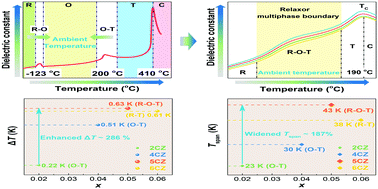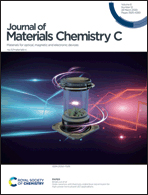Synergistically optimizing electrocaloric effects and temperature span in KNN-based ceramics utilizing a relaxor multiphase boundary
Abstract
A combination of large adiabatic temperature change (ΔT) and wide temperature span (Tspan) in lead-free ceramics is highly desired to develop eco-friendly and highly efficient solid-state refrigeration based on electrocaloric effects. However, the lack of success in synergistically optimizing both large ΔT and wide Tspan in one material impedes the practical applications of electrocaloric refrigeration technology. Here, a relaxor multiphase boundary (RMPB) is structured in (1 − x)(K0.49Na0.49Li0.02)(Nb0.8Ta0.2)O3–xCaZrO3 (KNLNT–xCZ) ceramics through intentional composition engineering, successfully achieving a region of multiphase coexistence accompanied by diffuse phase transition. A moderate ΔT (0.63 K under 80 kV cm−1) with a wide Tspan (43 K within 90% ΔT attenuation) is obtained in a relaxor KNLNT–5CZ ceramic with the coexistence of an R–O–T phase. The results indicate that a coupling effect originally from multi-directional polarization and polar nano-regions (PNRs) in RMPB contributes to the excellent performance combining large ΔT and wide Tspan. This work not only expands the applications of KNN-based ceramics from electric energy storage and piezoelectric applications to the refrigeration field, but also opens up a new design avenue for the development of high performance electrocaloric materials with broad temperature ranges.



 Please wait while we load your content...
Please wait while we load your content...